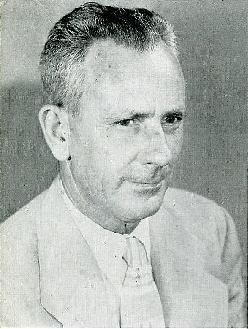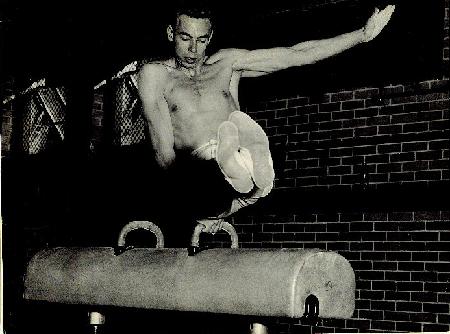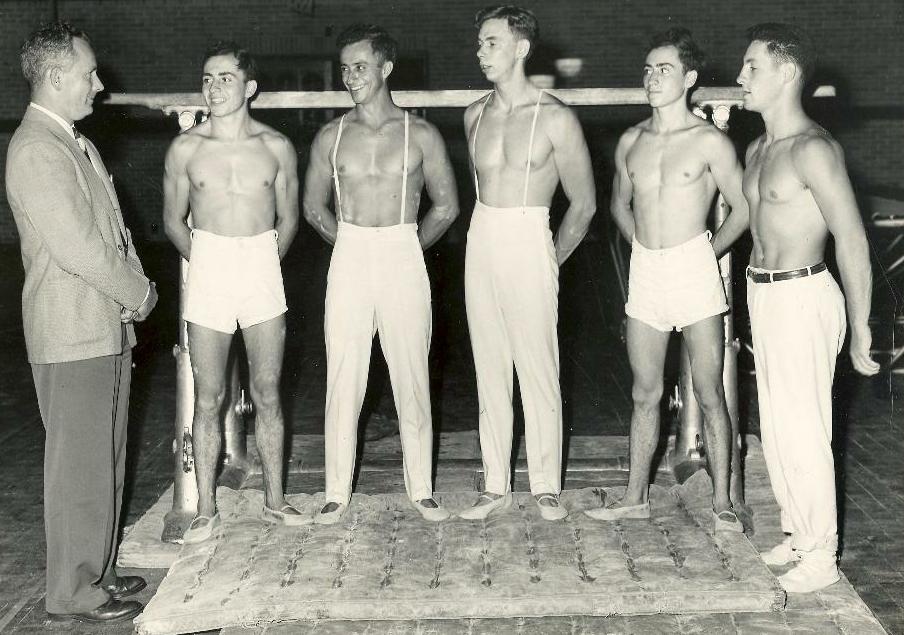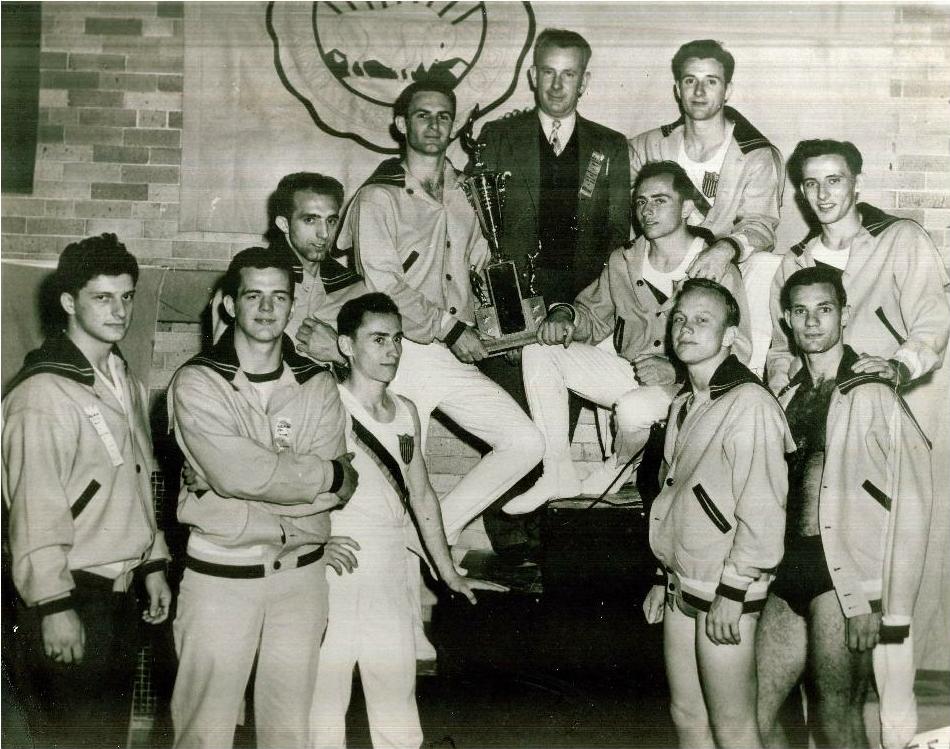Florida State University won its first ever collegiate national team championship in 1951. It was in the sport of men's gymnastics.
In the nineteen fifties, Florida State had one of the best gymnastics programs in the country. I was lucky enough to attend FSU during some of those gymnastics glory years. In writing this article I have been inspired by memories of watching those great athletes perform. I will always remember Bill Rotzheim gliding from apparatus to apparatus and Dick Gutting bounding almost to the ceiling off the trampoline. I also attended several of the Gymkana shows that spotlighted the skilled athletes performing in sync with music, dance routines, beauty contests, and pageantry at its best. In addition, I have had the benefit of two great sources of information on FSU's gymnastics history: (1) the book entlitled, The Spirit of Gymnastics: The Biography of Hartley D'Oyley Price (1982), by Tom Conkling; and (2) the web site, http://fsugymnastics.org maintained by Mike Mann. I am indebted to both sources for much of the substance of this article.
Howard Danford
Shortly after World War II ended, Florida State College for Women, became coeducational and renamed Florida State University. To accommodate the addition of male students, a men's physical education and athletics department was created. The unit had the multiple responsibilities of providing physical education courses and programs, operating a men's intramural program and administering FSU's entry into the world of male intercollegiate athletics. The pre-existing women's physical education department was retained and continued to provide academic and intramural physical education programs for women. There were no women's intercollegiate teams at FSU or for that matter at most colleges and universities in the nation.
Dr. Howard G. Danford was selected to head up FSU's new men's physical education and athletics department. Dr. Danford's attitude toward sports was considerably different than present day university athletic directors. While the big three sports, football, basketball and baseball were important to him, he placed almost equal importance upon other sports. Under his leadership, intercollegiate competition was organized in his first FSU school year, 1947-48, in football, basketball, baseball, tennis, golf and volleyball. In his second year at FSU, 1948-49, track and field as well as swimming were added to the mix.
At a physical education meeting in Kansas City, Missouri, Danford met Hartley Price, the gymnastics coach of the University of Illinois, who had already attained major status in the fledgling sport of gymnastics. Gymnastics was a sport which was quite popular in the Midwest and was expanding somewhat throughout the United States. Danford approached Price about coming to FSU to teach physical education and begin a gymnastics program. Price agreed to visit Tallahassee. The trip by Price and wife, "Billie", sold them both on the project and soon Price was added to the physical education faculty at Florida State. Almost magically and immediately upon Price's coming to town, Tallahassee became the "hot bed" of the expanding sport of gymnastics.
Hartley D'Oyley Price
 |
Hartley Price |
Hartley Price was born in Brisbane, Australia in 1902. As a youngster he played soccer and rugby but it was in gymnastics that he was most successful and competed on a national level. By the age of 20, young Price had served an apprenticeship in mechanical engineering. However, it was sports that was his passion. Price learned that Springfield College in Massachusetts was highly regarded as to its physical education teaching program. Consequently, at the age of 21, in March, 1924, Price crossed the ocean, and made his way to Springfield College. Soon, he got part time employment and gained admission to the school. While a student, he competed as a member of the school's gymnastics team. He was an outstanding student and by 1927 had obtained his B.S. degree in physical education. It was the first of five college degrees including a doctorate that Price would obtain during his lifetime.
In 1926, during his college days at Springfield, he met Dorothy Wills, of England. They were married when he graduated. "Billie", as she was called, became an important part of his life thereafter. In their tales about Price or "Hart", as they called him, former FSU gymnasts give Mrs. Price much credit for the success that her husband and FSU gymnastics had. They regard them as having been a very special tandem.
In the fall of 1927, the newly married couple moved to Champaign, Illinois, where Price became a part of the physical education faculty at the University of Illinois, a position that he occupied for the 21 years. One of the first things that he did at the University of Illinois was to install the sport of soccer not only at that institution but into the Big Ten Conference. In addition, in 1930, he was appointed the head gymnastics coach at the University of Illinois. In a short time, he became one of the prominent names in the fledgling sport that would eventually grow and gain popularity. In all, he would coach gymnastics for 41 years. At Illinois his teams won four national collegiate, two national AAU, and five Big Ten Conference championships.
In 1933 at the University of Illinois, Price founded the fraternity called "Gymnastica" which was composed of gymnasts and other students who organized and produced gymnastics shows. While at Illinois, he also made other contributions to sports including the introduction of tumbling into college cheerleading. In 1940 he organized a card display section for the university football games. The idea spread to a number of other colleges.
Price's career, like that of so many other Americans was interrupted by World War II. Soon after Japan's attack upon Pearl Harbor, Price volunteered and entered the United States Navy. He became a part of the Navy's aviation program and was assigned duties aimed at conditioning the Navy's pilots. He would rise in rank to Lieutenant Commander during the war.
After the war ended, Price had several options available to him. They included an offer by Auburn University to run its physical education program. He chose to return to Illinois but he and wife, Billie, after having lived for some time in California during his military duty had become quite desirous to live in a warmer climate in the future than existed in Illinois. Consequently, it struck a favorable chord when they later met Danford at that meeting in Oklahoma City and he talked about Tallahassee.
There was not much to work with when Price got to Tallahassee during the 1948-49 school year. The men's gymnasium was a wooden structure previously built for the Army Air Corps training base located a couple of miles from the main campus. The area where it was located served as a "West Campus" for FSU and the barracks located nearby served as housing for the male students that had just been added to the university.
 |
Bill Roetzheim |
Bill Roetzheim
It did not take Price long to move things along. By the next school year he had the gymnastics program going. He had even begun a tumbling program for local children which would be named the "Tallahassee Tumbling Tots." The program later became an integral part of the City of Tallahassee's recreation department and would serve thousands of children through the years. It continues to this day.
Several seasoned gymnasts who had earlier planned to go to the University of Illinois followed him to FSU. The most noteworthy was William H. "Bill" Roetzheim. Roetzheim, at 18 years of age, had been a member of the US's 1948 Olympics team. From Chicago, Roetzheim had competed for the the Navy Pier Branch of the University of Illinois and been a national AAU All Around gymnastics champion. Price also stimulated interest in gymnastics in other southern locations including the formation of a league of teams including ones from Georgia Tech and Duke.
FSU began competing in gymnastics in 1950 and went 4-0 in an abbreviated season when in dual meets they beat Indiana, Georgia Tech, Illinois-Chicago, and Maryland. In addition to competing against other colleges that team as well as the others to follow also competed in Amateur Athletic Union events. At the time, AAU competition was keener as it included more amateur teams and athletes and meant more in the selection process for membership in the national and Olympic teams. In AAU competition that 1950 team won the Mid-West, Southeastern and Florida AAU championships. In the national AAU championships, FSU did not win the team championship but Roetzheim won the All Around individual championship.

